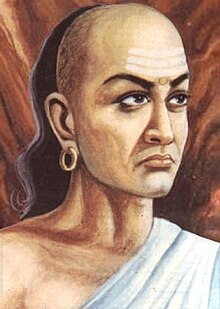Chakravarti (Sanskrit term)
ancient Indian term used to refer to an ideal universal ruler
A chakravarti is an ideal universal ruler, in the history, religion, and mythologies of India. The concept is present in Indian subcontinent cultural traditions, narrative myths and lore.

| This article related to India is a stub. You can help out with Wikiquote by expanding it! |
Quotes
edit- The area extending from the Himalayas in the north to the sea and a thousand yojanas wide from east to west is the area of operation of the King-Emperor.
- Chakravarti-kshetra as described by Chanakya (Kautilya): Arthashastra 9:1:17 (tr. L.N. Rangarajan), quoted from Elst, Koenraad (2001). Decolonizing the Hindu mind: Ideological development of Hindu revivalism. New Delhi: Rupa. p.457
- The Mahabharata carries a complete picture of this cultural unity in its tîrtha-yãtrã-parva, which is part of the larger Vana-parva. The Pandavas accompany their Purohita, Dhaumya, on a long pilgrimage to all parts of Bharatavarsha. They pay their homage to many mountains, rivers, samgamas, lakes, tanks, forest groves and other sacred shrines which had become hallowed by association with Gods and Goddesses, rishis and munis, satees and sãdhvees, heroes and heroines. And they feel fulfilled as they never did before or after in their long lives. The same Pandavas made an imperial conquest of the whole country, not once but twice and performed a rãjasûya yajña at the end of each triumph. But the Pandava empire is a faint memory of the forgotten past. On the other hand, the sacred spots which the Pandavas visited during their one and only pilgrimage, draw millions of devotees in our own days as they did in the distant past, long before the Pandavas appeared on the scene.
- S.R. Goel Muslim Separatism – Causes and Consequences (1983) by S.R. Goel
- The image of the whole of Bharatavarsha being a chakravartikshetra is as old as the oldest Vedic literature. The Itihasa-Purana provide glorious accounts of many chakravartins-Ikshvaku, Puru, Prithu Vainya, Sivi Ausinara, Mandhata, Raghu and so on-who accompanied the ašvamedha horse demanding submission from all kingdoms and republics, big and small, spread all over the country. The rãjasûya yajña which was performed at the end of this campaign was more in the nature of a meeting of equals than a durbar held by a despot in order to humble or humiliate subordinate princes and patriarchs. Sri Krishna had demanded death for Jarasandha because the latter had violated this dharmic tradition of empire-building, and kept a hundred kings captive in his castle. The Nandas had won notoriety as an ignoble dynasty because they had also violated the standard code of conduct laid down by the rãjadharma for righteous emperors, destroyed many local dynasties, and reduced other princes to provincial satraps.
- S.R. Goel Muslim Separatism – Causes and Consequences (1983) by S.R. Goel